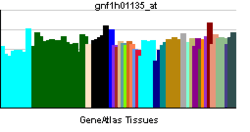LHX4
LIM/homeobox protein Lhx4 is a protein that in humans is encoded by the LHX4 gene.[3][4][5]
This gene encodes a member of a large protein family which contains the LIM domain, a unique cysteine-rich zinc-binding domain. The encoded protein may function as a transcriptional regulator and be involved in control of differentiation and development of the pituitary gland. Mutations in this gene are associated with syndromic short stature and pituitary and hindbrain defects. An alternative splice variant has been described but its biological nature has not been determined.[5]
References
- ↑ "Human PubMed Reference:".
- ↑ "Mouse PubMed Reference:".
- ↑ Liu Y, Fan M, Yu S, Zhou Y, Wang J, Yuan J, Qiang B (Feb 2002). "cDNA cloning, chromosomal localization and expression pattern analysis of human LIM-homeobox gene LHX4". Brain Res. 928 (1–2): 147–155. doi:10.1016/S0006-8993(01)03243-7. PMID 11844481.
- ↑ Machinis K, Pantel J, Netchine I, Leger J, Camand OJ, Sobrier ML, Dastot-Le Moal F, Duquesnoy P, Abitbol M, Czernichow P, Amselem S (Oct 2001). "Syndromic short stature in patients with a germline mutation in the LIM homeobox LHX4". Am J Hum Genet. 69 (5): 961–968. doi:10.1086/323764. PMC 1274372
 . PMID 11567216.
. PMID 11567216. - 1 2 "Entrez Gene: LHX4 LIM homeobox 4".
Further reading
- Li H, Witte DP, Branford WW, et al. (1994). "Gsh-4 encodes a LIM-type homeodomain, is expressed in the developing central nervous system and is required for early postnatal survival". EMBO J. 13 (12): 2876–85. PMC 395169
 . PMID 7913017.
. PMID 7913017.
- Howard PW, Maurer RA (2000). "Identification of a conserved protein that interacts with specific LIM homeodomain transcription factors". J. Biol. Chem. 275 (18): 13336–13342. doi:10.1074/jbc.275.18.13336. PMID 10788441.
- Kawamata N, Sakajiri S, Sugimoto KJ, et al. (2002). "A novel chromosomal translocation t(1;14)(q25;q32) in pre-B acute lymphoblastic leukemia involves the LIM homeodomain protein gene, Lhx4". Oncogene. 21 (32): 4983–4991. doi:10.1038/sj.onc.1205628. PMID 12118377.
- Strausberg RL, Feingold EA, Grouse LH, et al. (2003). "Generation and initial analysis of more than 15,000 full-length human and mouse cDNA sequences". Proc. Natl. Acad. Sci. U.S.A. 99 (26): 16899–16903. doi:10.1073/pnas.242603899. PMC 139241
 . PMID 12477932.
. PMID 12477932.
- Dattani MT (2004). "Borjeson-Forssman-Lehmann syndrome: a novel pituitary phenotype due to mutation in a novel gene". J. Pediatr. Endocrinol. Metab. 16 (9): 1207–9. doi:10.1515/jpem.2003.16.9.1207. PMID 14714741.
- Sobrier ML, Attié-Bitach T, Netchine I, et al. (2006). "Pathophysiology of syndromic combined pituitary hormone deficiency due to a LHX3 defect in light of LHX3 and LHX4 expression during early human development". Gene Expr. Patterns. 5 (2): 279–284. doi:10.1016/j.modgep.2004.07.003. PMID 15567726.
- Machinis K, Amselem S (2005). "Functional relationship between LHX4 and POU1F1 in light of the LHX4 mutation identified in patients with pituitary defects". J. Clin. Endocrinol. Metab. 90 (9): 5456–5462. doi:10.1210/jc.2004-2332. PMID 15998782.

 . PMID 11567216.
. PMID 11567216. . PMID 7913017.
. PMID 7913017. . PMID 12477932.
. PMID 12477932.